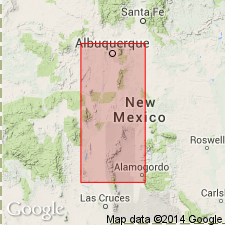
- Usage in publication:
-
- Mud Springs group
- Modifications:
-
- Named
- Dominant lithology:
-
- Limestone
- Chert
- Shale
- Sandstone
- AAPG geologic province:
-
- Orogrande basin
Summary:
Name proposed for all strata overlying Apodaca formation (new) of Green Canyon group (new) and probably unconformably underlying base of Des Moines series, Armendaris group (new). Name comes from Mud Springs Mountains northwest of Hot Springs where group is well exposed. Type locality is section measured near north end of Mud Springs Mountains at west end of Whiskey Canyon, just west of the westernmost box canyon, in SW1/4 sec 1, T13S, R5W, Sierra Co, NM in Orogrande basin. Lithology and thickness of Mud Springs group do not vary as markedly as that of underlying Green Canyon group. Recognized over a much larger area of NM, as well. Is 113 ft thick at type. Divided into two units: Hot Springs Formation (new, at base), composed of massive to nodular, highly cherty limestone and thick shale; and Cuchillo Negro Formation (new, at top), composed of massive to nodular, cherty limestone, with two thin beds of sandstone in lower portion. Is fossiliferous, containing gastropods, corals, bryozoans, crinoids, fusulinid foraminifers. Is of Pennsylvanian (Derry) age.
Source: GNU records (USGS DDS-6; Denver GNULEX).
For more information, please contact Nancy Stamm, Geologic Names Committee Secretary.
Asterisk (*) indicates published by U.S. Geological Survey authors.
"No current usage" (†) implies that a name has been abandoned or has fallen into disuse. Former usage and, if known, replacement name given in parentheses ( ).
Slash (/) indicates name conflicts with nomenclatural guidelines (CSN, 1933; ACSN, 1961, 1970; NACSN, 1983, 2005, 2021). May be explained within brackets ([ ]).

